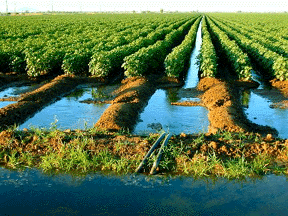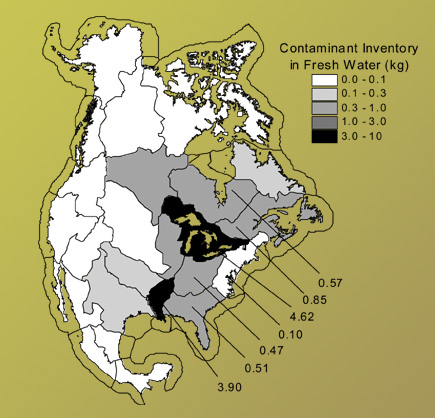|
|
 |
To better understand how contaminants such as pesticide travel across
the continent, researchers from Berkeley Lab and Canada's Trent University
have incorporated into a single model toxic release data, wind and water
current patterns, and regional differences such as soil and vegetation.
The BETR model, which derives its name from the two institutions involved,
improves on traditional atmospheric models by more completely reflecting
how persistent organic pollutants move and accumulate throughout North
America. Chiefly, contaminants such as dioxin, DDT, and mercury don't
simply drift with prevailing winds. They're also absorbed by the soil,
water, and vegetation because of a natural tendency to maintain equilibrium
with the environment. Whenever a persistent pollutant drifts into a region,
a percentage of it penetrates into the landscape until its air, soil,
vegetation, and water concentrations are in balance. If a new air mass
containing the same pollutant moves in, the equilibrium is unbalanced
and some of the absorbed compound is released until a new homeostasis
is attained.
 |
 |
|
|
 |
Whenever a persistant pollutant drifts
into a region -- toxaphene, for example, a banned pesticide that was
once widely used on cotton crops in the Southeast -- it penetrates
the landscape until concentrations in air, soil, vegetation, and water
are in balance. (Photo credit: Jack Joseph, Ed.D.) |
|
|
"This is how contaminants leapfrog across the continent, and why
air transport models don't really work for many persistent organic pollutants,"
says Tom McKone of Berkeley Lab's Environmental Energy Technologies Division.
In addition, because persistent pollutants are continuously absorbed
and reabsorbed as they drift with prevailing winds, conventional air tests
can easily underestimate the amount of contaminant in an area. At any
given time, most of the pollutant may be in the soil, not in the air.
To account for contaminants' complex jitterbug across the continent,
McKone's research group and his Trent University colleagues divided North
America into 24 regions largely based on watershed and soil type. In the
Midwest, for example, the Missouri and Cheyenne Rivers watershed region
is neighbored to the south by the Arkansas River-High Plains region. Each
region is further subdivided into seven compartments: upper atmosphere,
lower atmosphere, vegetation, soil, fresh water, coastal water, and freshwater
sediment. The characteristics of these compartments enable the model to
determine how each region absorbs a specific contaminant. For example,
soil absorbs chemicals based on its organic carbon content, water content,
and porosity, so a loamy soil absorbs chemicals differently than a clay
soil. Likewise, saltwater absorbs chemicals differently than fresh water.
And with vegetation, the more lipid contained in the leaves of a region's
plants, the more a fat-soluble chemical is absorbed.
Much like a chemical equation, the model pits the absorption traits of
each region's compartments (air, soil, etc.) against the solubility of
a specific contaminant. So, if airborne dioxin drifts into the Great Lakes
Basin region, the model runs seven mass balance equations -- one for each
equilibrium relationship between dioxin and the region's seven compartments
-- until the relative amount of dioxin in the air and environment is calculated.
To give the model a continental scale, a database of hydrological and
meteorological information determines how wind, rivers, and coastal water
ferry contaminants from region to region. By overlaying this transport
data onto 168 mass balance equations (seven for each of the 24 regions),
the model maps the pathway and eventual fate of a contaminant as it's
transported across North America.
 |
|
| The BETR model divides North America
into 24 regions by watershed and soil type. Each region is further
subdivided into seven compartments: upper atmosphere, lower atmosphere,
vegetation, soil, fresh water, coastal water, and freshwater sediment.
This map tracks a hypothetical release of toxaphene. |
|
So far, the model has been tested using real-world data associated with
toxaphene, a banned pesticide that was once widely used on cotton crops
in the Southeast and is now found in high concentrations in the Great
Lakes. The team introduced a hypothetical 10,000 kilogram-per-year release
in the lower atmosphere compartment of the Mississippi Delta region, and
the model determined that although the compound spread throughout much
of North America, the highest concentrations accumulated in the Great
Lakes.
"The model reproduces what we see in the real world," McKone
says.
The next step is to use the model to map human exposure, McKone says.
Although the BETR model tracks exposure based on inhalation, drinking
water, and skin contact, it can't account for the incredibly complex dynamics
that affect food-based exposure. A person can buy an apple in Chicago
that was grown in Washington State but contaminated by pesticides from
Mexico. To reflect this complexity, the mass balance of pollutants has
to be coupled with the mass balance of food. In other words, determine
where a region's fish, meat, milk, produce, and grains are imported from,
and backtrack to the source regions to determine how much contaminant
each food absorbed. McKone believes such a food-pollutant web will enable
EPA officials to not only determine whether there's too much pesticide
in Chicago's produce, but where the produce came from, and most importantly,
where the pesticide originated -- the root cause of the problem.
"The BETR model of contaminant fate is very important, but it's
an exercise in environmental chemistry," McKone says. "We can
add human exposure data to the model and help to better inform regulatory
policy."
Additional information:
|

